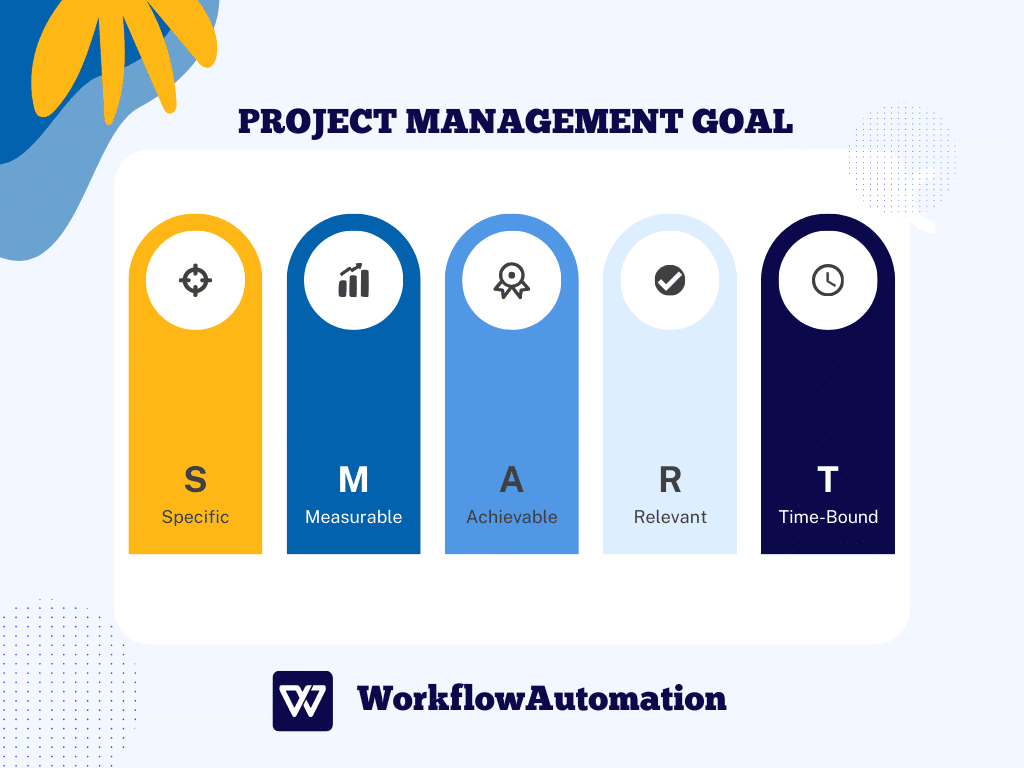If you’re overwhelmed by the multitude of project requirements and need help determining where to begin, your starting point should be clarifying your project management goals.
Defining these goals will serve as your compass, directing your efforts towards successfully tackling tasks and project phases and, ultimately, completing the entire project. With well-defined goals, you will avoid losing your way in uncertainty.
Now, let’s delve into why defining these goals is of utmost importance and uncover effective strategies for achieving them!
What Are Project Management Goals?
Project management goals refer to specific objectives or targets that a project team aims to achieve throughout the course of a project. These goals are very important to ensure the project goes the right way, stays on track, and ends up being a success.
Project management goals are typically set by the project manager in collaboration with stakeholders and team members to help the project team in different ways. They provide clarity and direction, help prioritize tasks, allocate resources effectively, and act as a basis for evaluating project success.
So, it’s essential to begin with a clear project management goals description, which outlines the desired outcomes and milestones the project is intended to achieve.
Project management goals are established during the project initiation phase, refined during planning, and continuously monitored and adjusted as needed throughout the project’s lifecycle.
Let’s take a look at some project management goal examples so that you can have a clear idea of what they look like:
- Complete project on time: Finishing the project within a specified timeframe, like completing a construction project within 12 months.
- Stay within budget: Keeping project costs within the allocated budget, e.g., not exceeding $500,000 for a marketing campaign.
- Achieve quality standards: Ensuring that project deliverables meet predefined quality criteria, such as producing error-free software code.
- Customer satisfaction: Reaching a customer satisfaction rating of at least 90% based on feedback surveys.
Why Are Project Management Goals Important?
Setting and adhering to project management goals is of great importance for successful project execution. Take a look at the list below to find more reasons why these goals are essential:
#1. They Increase Achievements
Clear project management goals enhance project team focus and motivation. When team members have a specific target to work toward, they are more likely to stay on task, meet deadlines, and produce high-quality work. The increased focus and commitment boost the chance of achieving project objectives efficiently.
#2. They Improve Processes
Having clear project management goals requires careful planning and organization. This, in turn, leads to improved project processes. The act of setting goals requires a thorough understanding of project requirements, potential risks, and effective resource management.
Consequently, it promotes better decision-making and overall project efficiency. On the other hand, as a goal is achieved, the team gains valuable insights into what works best, allowing for continuous process improvement. This constant adjusting of processes increases output and makes it easier to finish projects on time and on budget.
#3. They Enhance Communication
Project management goals serve as a common reference point for all stakeholders. They facilitate clear and effective communication among team members, sponsors, and clients.
Everyone understands what is expected, which minimizes misunderstandings and conflicts and fosters collaboration. Additionally, effective communication, enabled by well-defined goals, ensures that everyone is on the same page regarding project priorities, progress, and potential issues.
This alignment not only strengthens teamwork but also enhances client satisfaction as expectations are consistently met and managed.
#4. They Enable Evaluation and Adaptation
These goals provide a basis for evaluating a project’s progress and success. By checking in on a regular basis to see if goals are being met, changes and improvements can be made in a timely manner.
This adaptability is crucial in addressing unforeseen challenges and ensuring the project remains aligned with its intended outcomes. By having clear goals, project managers can identify deviations from the plan early and take corrective actions.
This ability to adapt ensures that the project stays on course and remains responsive to changing circumstances, which leads to increased chances of delivering the desired results.
How to Set Project Management Goals?
Setting project management goals is crucial for achieving success, and this is a mantra that everyone already knows. But how do you do it?
There are various ways, but you can’t go wrong if you choose the SMART goals method. SMART is an acronym that stands for Specific, Measurable, Achievable, Relevant, and Time-bound.
Let’s see what this means:
- Specific: Goals should be well-defined and clear, leaving no room for ambiguity. A specific goal should answer the questions: What, why, and how?
- Measurable: Goals should have quantifiable criteria for success. This enables you to track progress and determine when the goal is achieved.
- Achievable: Goals should be realistic and attainable. They should challenge you but remain within the realm of possibility.
- Relevant: Goals must align with your project’s overall objectives. They should contribute meaningfully to your project’s success.
- Time-bound: A deadline for achieving the goal should be set. This adds urgency and helps in managing time effectively.
8 Examples of Project Management Goals
Let’s explore some project management goals examples to help you navigate your project effectively while formulating strategies within the necessary project domains and ensuring successful execution.
#1. Productivity Improvement
This goal entails continuously increasing efficiency in your work processes and consistently achieving better results.
Whether it translates into higher output volumes, meeting deadlines sooner than planned, or any other form of improvement, it’s crucial to work towards consistently surpassing past achievements.
This approach leads to quicker project completion, cost savings, and improved quality, resulting in greater client satisfaction and overall project success.
To achieve this goal, project managers can implement various strategies, such as utilizing time management techniques, implementing business process automation, providing training to team members, or using productivity-enhancing tools.
By implementing multiple practices and closely monitoring their impact on your operations, you can consistently track your progress, identify bottlenecks, and continually enhance your business.
The benefits you’ll experience with this approach usually manifest as effortlessly meeting project deadlines, lowering overall project costs, and ultimately elevating customer satisfaction.
#2. Budget Control
Budget control is a project management goal that centers on the financial aspect of your project —effectively managing project finances.
This goal ensures that the project remains within budgetary constraints, mitigating the risk of cost overruns. Achieving this goal involves project managers creating a detailed budget plan encompassing all necessary inputs and their proper allocation and utilization.
Your budget must be monitored throughout the project’s execution to gauge compliance with the planned costs and to assess if any adjustments are required. Carefully consider these adjustments to prevent exceeding or depleting the budget entirely.
Your budget must cover all relevant expenses, including materials, labor, and equipment. Moreover, allocate budget for unforeseen circumstances, ensuring the project can continue smoothly despite unexpected expenses.
Transparency is vital in budget management. Sharing your budget and planned expenditure strategies with stakeholders fosters trust and open, honest relationships. With a well-planned budgetary framework, you can prioritize spending and allocate resources efficiently, ensuring financial stability and enhancing the project’s credibility.
#3. Stakeholder Expectation Management
Managing stakeholder expectations involves identifying, comprehending, and meeting the needs and expectations of project stakeholders. Giving attention to stakeholders is imperative as they can influence the project’s development and outcome.
Therefore, recognizing their significance and impact on the project is crucial for maintaining a productive relationship with them.
For instance, consider a stakeholder with expertise in a critical project-related domain. Effective communication with such an individual is instrumental in ensuring well-informed decision-making throughout the project’s journey.
This approach ensures that choices are rooted in reliable information, leading to practical and efficient solutions.
Planning and executing projects in alignment with the project vision and the expectations of stakeholders (clients, team members, and investors) significantly enhance the likelihood of satisfying everyone involved.
Furthermore, meeting and potentially exceeding their expectations cultivates a relationship based on trust, increasing confidence in the project’s management and delivery.
#4. Resource Optimization
The objective of resource optimization is to ensure the effective utilization of all project resources, including workforce, budget, and equipment. Effective resource allocation maximizes productivity, minimizes waste, and reduces costs.
To achieve optimization, carefully plan and allocate resources, continuously monitor their usage, and regularly reassess resource needs throughout the project. This approach improves cost control, enhances project efficiency, and ultimately increases profitability.
#5. Collaboration & Communication Improvement
The primary aim of this goal is to enhance collaboration and communication among project team members and stakeholders. Effective collaboration and communication reduce misunderstandings and make for a great team.
Foster an environment where everyone feels comfortable sharing their thoughts and every perspective is recognized and valued. Given the direct involvement of project team members in day-to-day operations and the challenges these individuals encounter, their work contributions can significantly enhance process improvements.
Therefore, establish clear communication channels, using communication apps like Slack or Discord, and conduct regular team meetings to remain up-to-date. Ultimately, these efforts will lead to improved decision-making and a more dedicated and motivated team.
#6. Risk Management
Effective risk management involves identifying, preparing for, and minimizing potential project issues or uncertainties to ensure smoother execution within established timelines and budgets.
To achieve this, involving experts from the outset for thorough risk assessments or using suitable project management tools is essential. Create plans to manage potential risks and strategies if they occur.
This approach maintains flexibility to adapt to changing circumstances and reduces unexpected challenges.
#7. Quality Assurance
Quality assurance focuses on maintaining and improving the quality of project deliverables and processes throughout the project lifecycle. Ensuring high-quality outputs helps meet stakeholder expectations and reduces the need for costly rework.
Therefore, establish clear quality standards, conduct regular quality audits, and promptly implement corrective actions when you identify deviations.
Additionally, refine customer support to effectively gather and communicate consumer feedback, opinions, recommendations, and more. This approach will enhance customer satisfaction, decrease defects, and improve the project’s reputation.
#8. Timely Milestone Achievement
The goal of achieving milestones and deadlines as planned is critical for maintaining project momentum and keeping stakeholders informed and satisfied.
Defining project milestones simplifies progress tracking, increases employee focus on achieving objectives step by step, and enhances project predictability. Furthermore, it builds stakeholder trust and improves overall project control.
Therefore, create a detailed project schedule, consistently monitor progress, and be prepared to make necessary adjustments to stay on track with milestones.
Project Management Goals vs. Project Management Objectives
In the realm of project management, goals and objectives are two distinct but closely related concepts. So, let’s expose the differences between them.
Project management goals are the high-level, overarching outcomes that a project aims to achieve. They provide the project’s purpose and direction. Goals focus on the “what” and “why” of a project. For example, a goal might be to “increase customer satisfaction by improving product quality.”
Project management objectives, on the other hand, are the specific, measurable, and time-bound targets that support these goals. They provide the roadmap for reaching the goals, answering the “how” and “when”. Building on the previously mentioned example, an objective could be to “reduce product defects by 20% within six months.”
In essence, goals define the broader mission of a project, while objectives break down the steps needed to accomplish that mission.
5 Tips on Setting Project Management Goals
The following five tips will assist you in setting project management goals correctly:
- Diversify goal types: Instead of focusing solely on outcome-based goals, incorporate a mix of goal types. Include performance goals (e.g., quality improvements), learning goals (e.g., acquiring new skills), and outcome goals (e.g., project completion). This variety provides a balanced perspective on project success and encourages continuous improvement.
- Make some goals optional: Not all goals need to be rigidly mandatory. Allow for some flexibility in achieving certain objectives. Flexibility empowers your team to adapt to unexpected challenges, fostering creativity and problem-solving while still working toward the project’s success.
- Consider team members’ strengths and weaknesses: Leverage your team’s unique skills and abilities when setting goals. Assign tasks and responsibilities that align with their strengths and provide opportunities for growth in areas where they may be less experienced.
- Regularly review and adjust goals: Projects are dynamic, and circumstances can change. Regularly review and, if necessary, adjust your goals to reflect current realities. This ensures that your objectives remain relevant and attainable throughout the project’s lifecycle.
Conclusion
In the world of project management, goals serve as the guiding light that leads teams to success. They are the foundation upon which effective projects are built.
By setting project management goals, project managers ensure that their teams stay on course, improve processes, and maintain open lines of communication. Goals empower teams to adapt and thrive in the face of challenges, ultimately delivering outstanding results.
As you embark on your project management journey, always remember the transformative power of well-defined goals! They are your allies, which can help you to turn visions into reality.







